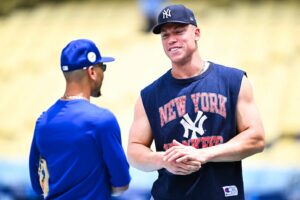‘The JLCO Plays the 70s’
Jazz at Lincoln Center Orchestra
Frederick P. Rose Hall
Streaming Through June 6
Audience members could tell it was going to be an especially fun show for the Jazz at Lincoln Center Orchestra when its regular announcer, Billy Banks, introduced the program with a variation on a familiar aphorism: that if you can actually remember the 1970s, then you probably weren’t really there. Then, after the first number — “Humpty Dumpty” by Chick Corea — the evening’s musical director and host, Ted Nash, informed us that he was selected for that role because he was the only one present who could, in fact, remember that decade. This he then proved with a story about being hired by Quincy Jones in 1976, at the age of 16.
As the 2024-25 JALC season nears its conclusion — there’s one more big event on the weekend starting June 13, “Best of the JLCO with Wynton Marsalis” — most of the orchestra seemingly would be at a loss to remember the turn of the millennium, let alone the 1970s. Mr. Nash, who, a year ago stepped down after 30 years as a regular member of the reed section, assembled a program of superior jazz compositions from those years as well as two items better described as popular songs. In fact, a particular highlight was Stevie Wonder’s “All In Love is Fair,” arranged for the JLCO by saxophonist Sherman Irby, who, born in 1968, is now one of the veteran members of the ensemble.
For Jazz at Lincoln Center to celebrate the 1970s is a particularly meaningful event. We tend to think of that decade — admittedly somewhat reductively — as the major age of jazz-rock fusion. When the future director of JALC, Wynton Marsalis, released his first album in 1982, he symbolized a movement away from fusion and back to older and what were considered purer styles like bebop, swing, and New Orleans-style jazz.
To that point, if you had asked me a few years ago, I might have said that the work I would have least expected to hear at Jazz at Lincoln Center was Gil Scott-Heron’s “The Revolution Will Not Be Televised,” which as Mr. Nash correctly pointed out presaged the entire rap and hip-hop movements. As arranged by drummer Obed Calvaire and featuring Chris Crenshaw, speaking with his resplendent baritone and playing his tenor trombone, this piece was among the most purely fun I’ve ever heard at Rose Hall.

The program assembled by Mr. Nash notably did not include any out-and-out examples of fusion, but in some cases it narrowly skirted the edge. Instead, there was straight down the middle bebop (“Humpty Dumpty” and Charles McPherson’s “Horizons”), funk-infused soul jazz (Nat Adderley’s “Hummin’” arranged by Michael Leonhart), classic hard bop (Horace Silver’s “Barbara”), Afro-Latin jazz (Tom Harrell’s “Terrestris”), world jazz (Toshiko Akiyoshi’s “Since Perry / Yet Another Tear”), and even a chart representing the Great American Songbook and a very much updated brand of big band swing (Bill Holman’s take on “Lover Man”).
And yes, Mr. Nash and the ensemble did address the music of one of the flagship ensembles of the fusion movement, or at least its two key composer-leaders, Joe Zawinal and Wayne Shorter. For Shorter, it played “Angola,” from a 1965 session released on the 1979 album “The Soothsayer,” a moody, complex piece highlighting saxophonists Paul Nedzilla (baritone) and Chris Lewis (soprano).
The evening was highlighted by two actual veterans of the era, genuine jazz giants who flourished in the “me decade,” trumpeter Tom Harrell, now 78, and alto saxophonist Charles McPherson, 85. Each was featured in new orchestrations of one of their vintage tunes from the era as well as another piece from their musical history. For Mr. Harrell it was “Terrestris”; I’ve always thought of his music as highly complex and intense, but this was relatively relaxed and accessible, reminiscent of “Freedom Jazz Dance.” He then shined on “Barbara,” a jazz waltz that he had played in 1975 years ago with Silver.
Mr. McPherson played the boppish “Horizons” that featured a powerhouse trumpet solo by Bruce Harris, sitting in Mr. Marsalis’s chair, and the warm, expressive “Lover Man.”
The other major relatively traditional love song was “All in Love is Fair,” which included more dissonances than you might expect and featured Chris Crenshaw. One couldn’t help but wish that the next time that the orchestra collaborates with a major pop star — as it has with Paul Simon and Willie Nelson, among others — that by rights it should be Stevie Wonder. It’s easy to make the case that Mr. Wonder has inspired more jazz activity than any popular composer of the era, with the possible exception of Michel Legrand.
The evening ended with a driving flagwaver from the Weather Report book, Zawinal’s iconic “Birdland,” opening with Mr. Nedzilla on bass clarinet and pianist Helen Sung switching between the traditional instrument and an electric keyboard.
Friday’s concert ended with a genuine surprise: a chorus of “Happy Birthday” sung to Mr. Banks, who made a rare foray onto the stage, reminding us of what he looks like. It was a poignant reminder of the passage of time, that the 1970s are now somehow 50 years in the past. Even the Voice of God himself is getting older.



